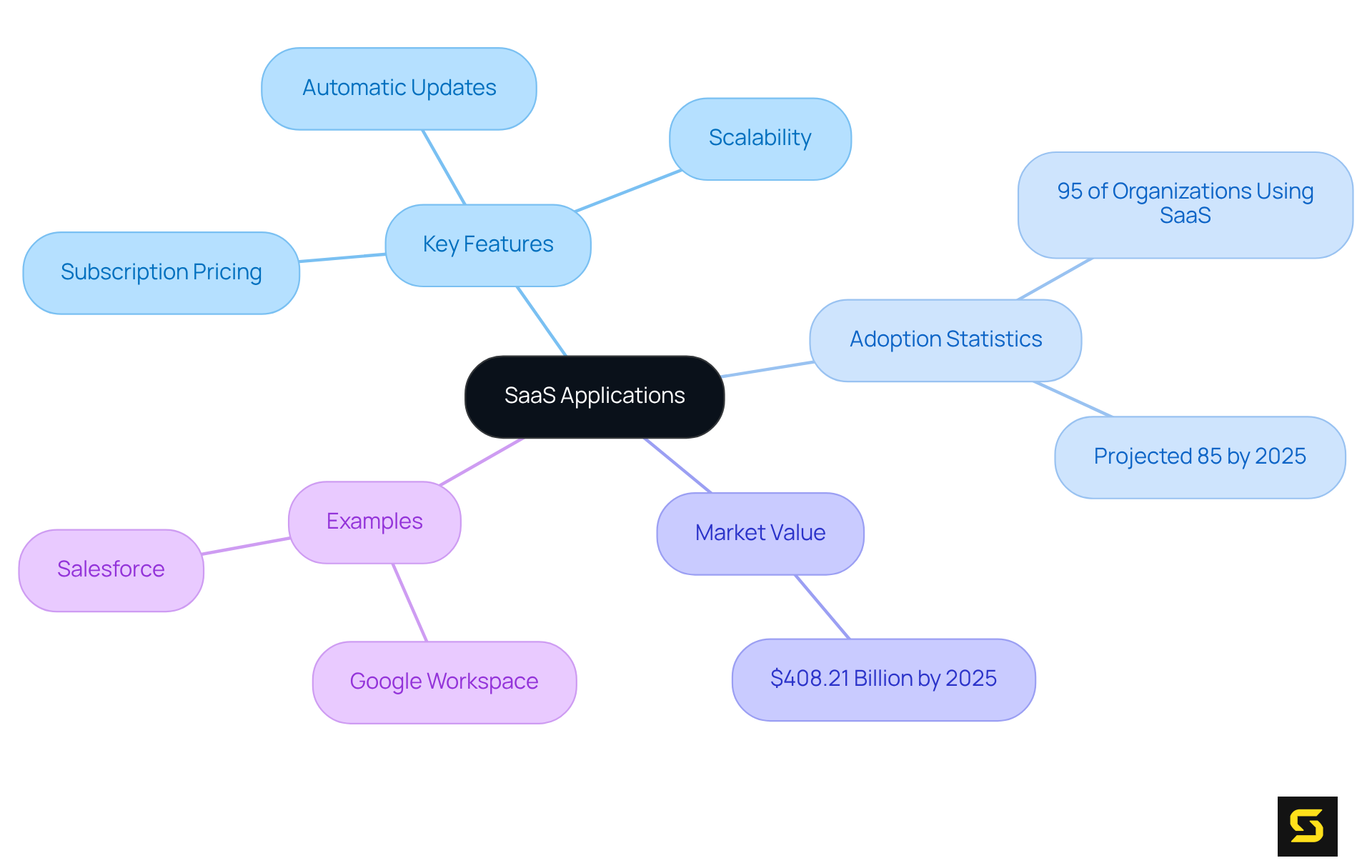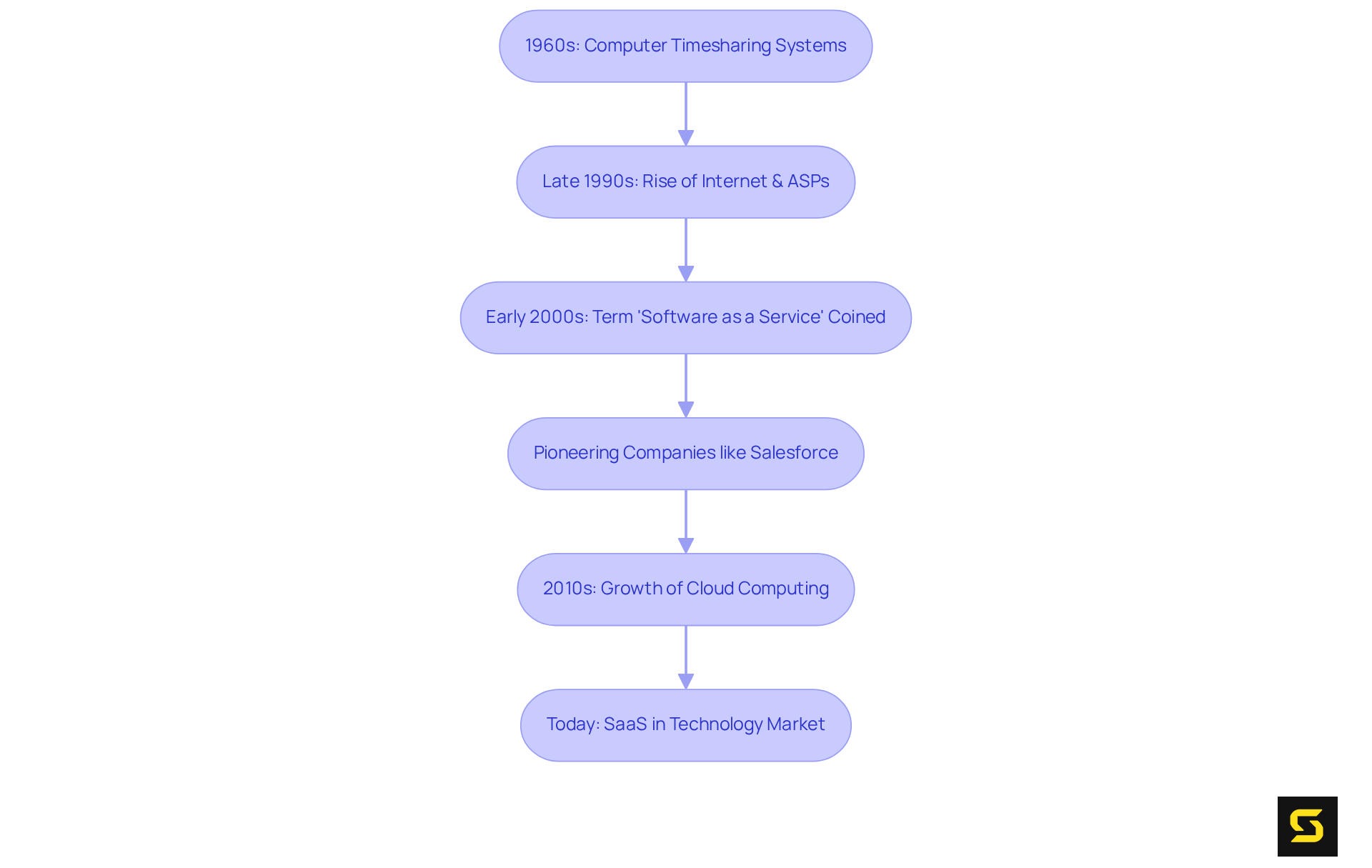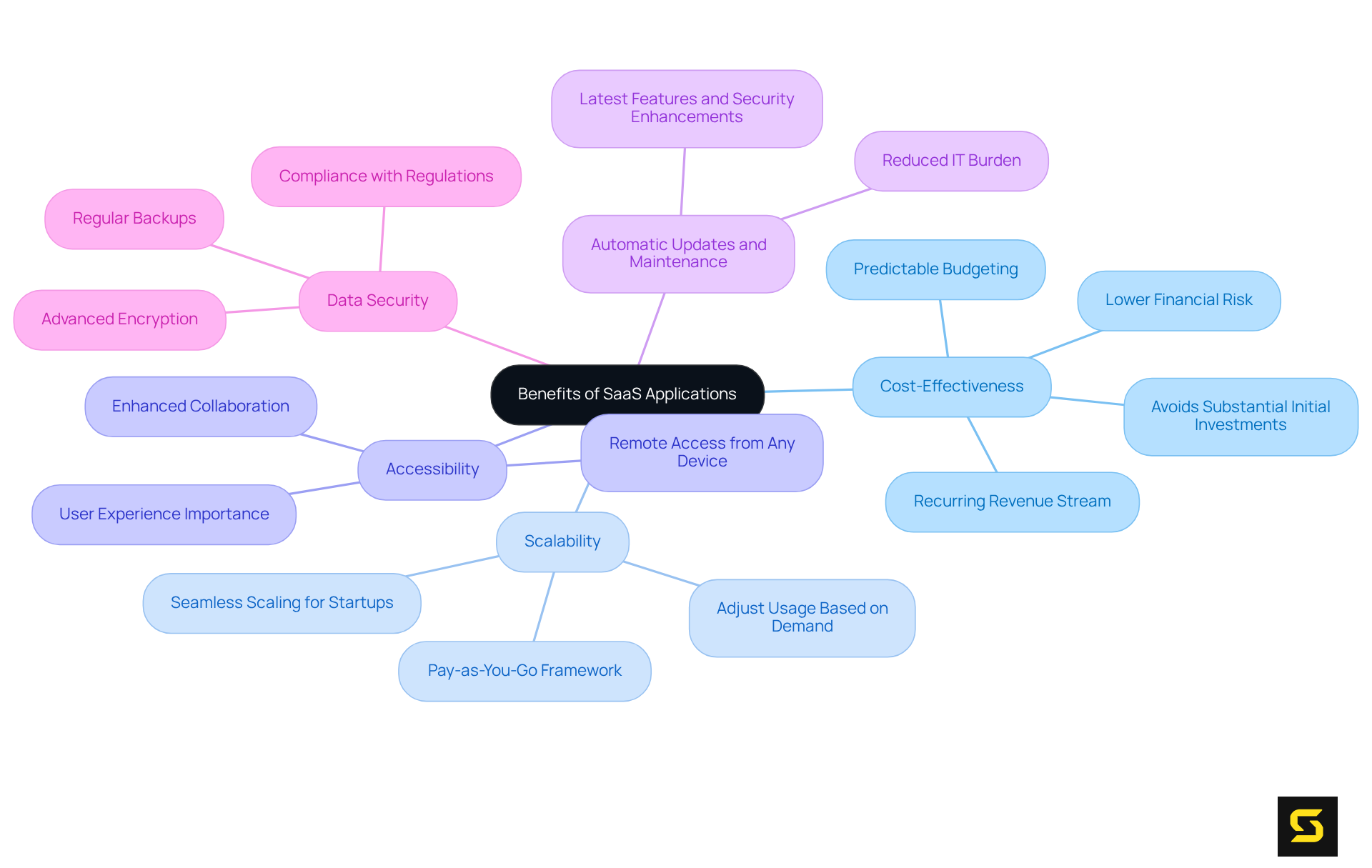Overview
SaaS applications, defined as software hosted by service providers and accessed via the internet, have undergone remarkable evolution since their inception. This evolution has brought forth significant benefits, including cost-effectiveness, scalability, and accessibility for organizations. By tracing the historical context of SaaS, we can observe its rise in popularity, largely driven by advancements in cloud computing. This transformative impact on business operations has positioned SaaS as the preferred choice for modern enterprises, making it an essential component of contemporary business strategy.
Introduction
The emergence of Software as a Service (SaaS) has fundamentally transformed how businesses access and utilize software, moving away from traditional installations toward flexible, cloud-based solutions. This paradigm shift not only drives down costs but also significantly boosts operational efficiency, positioning SaaS applications as indispensable tools for organizations of all sizes.
Yet, as the market continues to evolve, what challenges and opportunities await businesses eager to harness these innovative solutions? By delving into the definition, evolution, and advantages of SaaS applications, we uncover vital insights into their profound impact on the contemporary business landscape.
Define SaaS Applications: Core Concepts and Characteristics
Software as a Service (SaaS) represents a transformative SaaS application delivery model wherein programs are hosted by a service provider and accessed by users via the internet. This innovative approach eliminates the necessity for local installation, providing substantial flexibility and ease of use. Key features of a SaaS application include:
- Subscription pricing
- Automatic updates
- Scalability
Together, these elements empower companies to minimize initial expenses associated with software acquisitions and ongoing maintenance. As of 2023, approximately 95% of organizations have adopted SaaS applications, highlighting their growing importance in the corporate landscape. By 2025, it is projected that 85% of all applications will be SaaS applications, further emphasizing the model's widespread acceptance. Notably, the global SaaS application market is expected to reach around $408.21 billion by 2025, highlighting its critical role in the industry.
A SaaS application enables small and medium enterprises to access applications that would otherwise be prohibitively expensive due to high licensing fees. Examples of software applications such as Google Workspace and Salesforce showcase the diverse functionalities available across various sectors, ranging from productivity tools to customer relationship management. These applications not only streamline operations but also enhance collaboration and efficiency, making the SaaS application an attractive option for organizations of all sizes. Furthermore, many software service providers deliver 24/7 customer support, significantly enhancing user experience and satisfaction. The integration of AI technologies in software-as-a-service offerings is also noteworthy, as it enhances functionalities and fosters innovative solutions.

Explore the Evolution of SaaS: Historical Context and Market Impact
The concept of software as a service has its origins in the early 1960s, when computer timesharing systems enabled multiple users to access a single computer simultaneously. However, it was in the late 1990s, with the rise of the internet and the introduction of Application Service Providers (ASPs), that the contemporary software-as-a-service model began to take shape.
By the early 2000s, the term 'Software as a Service' was officially coined, and pioneering companies like Salesforce played a pivotal role in popularizing this innovative model. The rapid growth of cloud computing throughout the 2010s propelled SaaS applications into the mainstream, fundamentally transforming how software is created, delivered, and utilized.
Today, cloud-based services command a substantial share of the technology market, driven by an increasing demand for digital transformation across various sectors. This evolution has not only reshaped the software landscape but has also influenced commercial models, underscoring the importance of agility and scalability in business operations.
A landmark moment in this journey was the introduction of Google Workspace in 2006, which significantly contributed to the popularity of cloud software by showcasing its potential to enhance collaboration and productivity. Moreover, the rise of vertical SaaS applications and micro software solutions exemplifies the ongoing innovation within this sector, effectively addressing specific market needs and further solidifying the role of SaaS applications in modern business.

Identify Key Benefits of SaaS Applications: Efficiency, Scalability, and Accessibility
SaaS applications offer significant advantages that improve operational efficiency and user experience. A primary benefit is their cost-effectiveness; organizations can avoid substantial initial investments in hardware and software by adopting a subscription model that aligns with their financial capabilities. This approach not only reduces upfront costs but also facilitates predictable budgeting, which is essential for organizations striving to maintain cash flow. Analysts project that the software-as-a-service market will exceed $1 trillion by 2032, highlighting the growing trend toward subscription-based solutions.
Moreover, SaaS applications are inherently scalable, enabling businesses to adjust their usage based on demand without incurring the costs associated with major infrastructure changes. This flexibility is particularly advantageous for startups and rapidly expanding companies, allowing them to scale operations seamlessly as their needs evolve. As Phil Lombardi aptly notes, "The software-as-a-service model functions on a pay-as-you-go framework, enabling users to pay subscription charges gradually and according to usage."
Accessibility is another critical aspect of SaaS applications as service solutions. Users can access applications from any device with an internet connection, promoting remote work and enhancing collaboration among teams. This capability is increasingly vital in today's work environment, where flexibility and mobility are paramount. In fact, 85% of customers are willing to invest more in a software product if the user experience is favorable.
Furthermore, a SaaS application automatically manages updates, ensuring that users consistently benefit from the latest features and security enhancements without overburdening IT departments. This continuous improvement not only boosts user satisfaction but also fortifies data security, as providers implement advanced measures to safeguard sensitive information. For instance, software as a service providers often employ specialists in software development to enhance data security for clients, utilizing cloud technology for data storage and backup.
In conclusion, the combination of cost-effectiveness, scalability, and accessibility positions SaaS applications as a compelling choice for modern businesses aiming to innovate and maintain a competitive edge in their markets.

Conclusion
Software as a Service (SaaS) stands as a pivotal model in the software industry, fundamentally transforming the delivery and utilization of applications. This innovative approach streamlines access to essential tools, significantly reduces costs, and enhances operational flexibility for organizations of all sizes. The rising adoption of SaaS underscores its profound impact on business efficiency, scalability, and accessibility.
This article delves into the core characteristics of SaaS applications, emphasizing their:
- subscription-based pricing
- automatic updates
- scalability
It traces the evolution of this model from its origins in the 1960s to its current status as a cornerstone of digital transformation, showcasing how major players like Salesforce and Google Workspace have shaped its trajectory. Furthermore, the benefits of SaaS applications are outlined, highlighting their:
- cost-effectiveness
- ease of access from any device
- automatic management of updates that bolster user satisfaction and security
In light of these insights, embracing SaaS applications is not merely a trend; it is a strategic move for businesses striving to thrive in a competitive landscape. With the SaaS market projected to exceed $1 trillion by 2032, organizations are encouraged to leverage these tools to enhance collaboration, drive innovation, and maintain agility. The future of software is undoubtedly intertwined with the SaaS model, making it imperative for businesses to adapt and integrate these solutions into their operational frameworks.
Frequently Asked Questions
What is SaaS?
SaaS, or Software as a Service, is a software delivery model where applications are hosted by a service provider and accessed by users over the internet, eliminating the need for local installation.
What are the core characteristics of SaaS applications?
Key characteristics of SaaS applications include subscription pricing, automatic updates, and scalability.
How does SaaS benefit organizations financially?
SaaS applications help organizations minimize initial costs associated with software acquisitions and reduce ongoing maintenance expenses.
What is the current adoption rate of SaaS applications among organizations?
As of 2023, approximately 95% of organizations have adopted SaaS applications.
What is the projected future of SaaS applications in the corporate landscape?
By 2025, it is projected that 85% of all applications will be SaaS applications.
What is the expected market value of the global SaaS application market by 2025?
The global SaaS application market is expected to reach around $408.21 billion by 2025.
How do SaaS applications benefit small and medium enterprises?
SaaS applications allow small and medium enterprises to access software that would otherwise be too expensive due to high licensing fees.
Can you provide examples of SaaS applications?
Examples of SaaS applications include Google Workspace and Salesforce, which offer functionalities ranging from productivity tools to customer relationship management.
What additional support do many SaaS providers offer?
Many SaaS providers offer 24/7 customer support, enhancing user experience and satisfaction.
How is AI integrated into SaaS applications?
The integration of AI technologies in SaaS offerings enhances functionalities and fosters innovative solutions.





